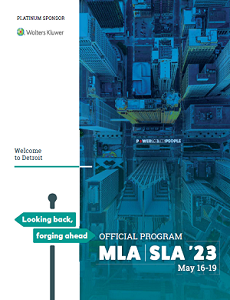Paper: Research Abstract
Information Services
In Person
On Demand
Session: Information Services Papers 3
The Role of Libraries and Librarians at the Intersection of Public Health and the Arts
Friday, May 19, 2023
1:30 PM - 1:45 PM EDT
Location: 252A
- KS
Karin J. Saric
Medical Librarian
Norris Medical Library
Los Angeles, California
Author and Main Contact(s)
Objectives: This paper explores the role of libraries and librarians at the intersection of public health and the arts, within the framework of Creative Placemaking (CP). CP is a community development design structure that makes intentional use of local places, and can leverage the power of the arts to connect people, expose root issues, center underrepresented voices and concerns, and shift sociocultural norms and collective behaviors. Over the last few decades CP has been widely integrated throughout the healthcare environment, including creation of evidence-based findings that support the benefits of incorporating such a framework into public health work.
Methods: Using historiography as a research method, the author formulated a series of questions that focused on gaining understanding of the underlying theories, frameworks, and evolution of programming within the sectors of Creative Placemaking, public health, knowledge translation, the arts in healthcare, and libraries as place over the last few decades. Literature, reports, online documentation, and websites were reviewed and analyzed to identify themes across the various focus areas, implementation of successful programming, and to identify areas where libraries and librarians can make future contributions. A resource list was created that includes links to key groups, toolkits, frameworks, and relevant literature.
Results: Themes that emerged include focusing on community level behavioral change, and formalizing work at institutional levels in order to scale to broader environments. Research evidence supports the ability of arts-based programming to engage populations by transcending barriers such as language, traditions, and belief systems. While performing & visual arts, and interactive activities were found to impact behavior, the most relevant factor that induced change was active involvement in the creation of art. As libraries are trusted, networked, centrally located public spaces, they are natural partners in the effort to provide access to arts-based programming that focuses on health behavior change.
Conclusions: Public health has moved into a fifth wave that focuses on creating a community level “culture of health”. Using the CP framework, libraries can impact community level health behavior in two ways. Locally, they can increase dissemination of reliable health information, that supports behavior change, by formally incorporating evidence-based arts programming within collaborative learning environments. At the institutional level, collaborative, capacity building efforts can leverage nationwide networks to incorporate consistent, robust, evidence-based, arts programming within community-based health models, such as that of social prescribing. The main challenge within libraries is the lack of staff to coordinate and run such robust programming. Libraries should hire community engagement librarians to address the scope of the work required to succeed in such endeavors.
Methods: Using historiography as a research method, the author formulated a series of questions that focused on gaining understanding of the underlying theories, frameworks, and evolution of programming within the sectors of Creative Placemaking, public health, knowledge translation, the arts in healthcare, and libraries as place over the last few decades. Literature, reports, online documentation, and websites were reviewed and analyzed to identify themes across the various focus areas, implementation of successful programming, and to identify areas where libraries and librarians can make future contributions. A resource list was created that includes links to key groups, toolkits, frameworks, and relevant literature.
Results: Themes that emerged include focusing on community level behavioral change, and formalizing work at institutional levels in order to scale to broader environments. Research evidence supports the ability of arts-based programming to engage populations by transcending barriers such as language, traditions, and belief systems. While performing & visual arts, and interactive activities were found to impact behavior, the most relevant factor that induced change was active involvement in the creation of art. As libraries are trusted, networked, centrally located public spaces, they are natural partners in the effort to provide access to arts-based programming that focuses on health behavior change.
Conclusions: Public health has moved into a fifth wave that focuses on creating a community level “culture of health”. Using the CP framework, libraries can impact community level health behavior in two ways. Locally, they can increase dissemination of reliable health information, that supports behavior change, by formally incorporating evidence-based arts programming within collaborative learning environments. At the institutional level, collaborative, capacity building efforts can leverage nationwide networks to incorporate consistent, robust, evidence-based, arts programming within community-based health models, such as that of social prescribing. The main challenge within libraries is the lack of staff to coordinate and run such robust programming. Libraries should hire community engagement librarians to address the scope of the work required to succeed in such endeavors.

.png)
